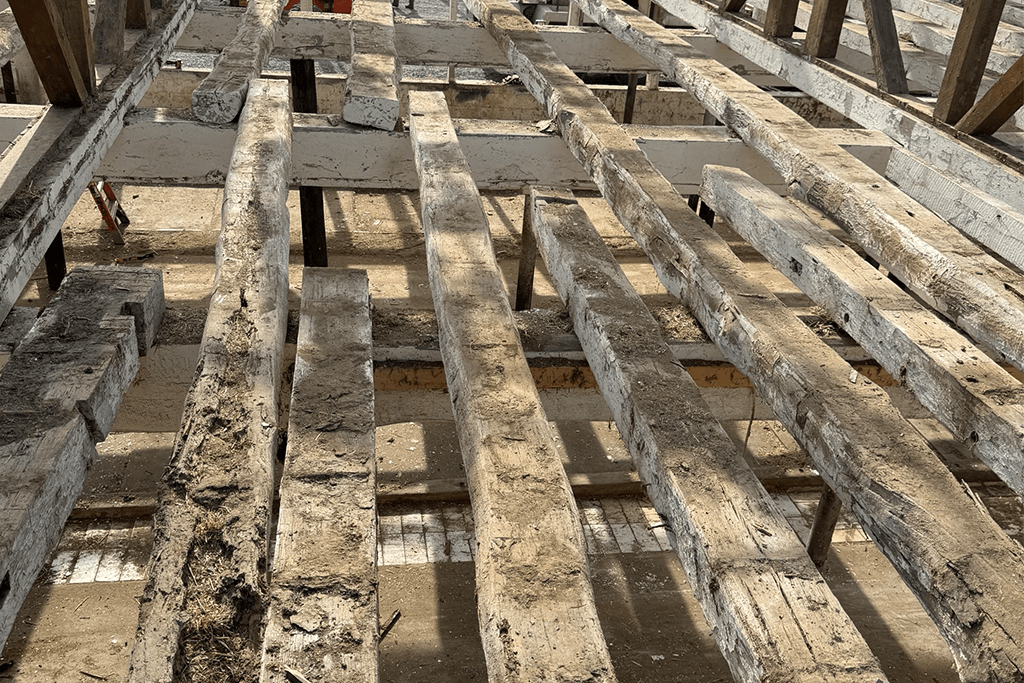From rich hardwood floors to live-edge tables, reclaimed wood has a place in every home. But like most things, it requires a little maintenance now and then. Here are our tips for how to clean reclaimed wood to preserve its beauty and charm.
Why Cleaning Reclaimed Wood Is Important
All reclaimed wood, whether it’s finished and installed in your home or freshly salvaged from an old barn, needs some basic maintenance. Cleaning wood furniture and accessories helps preserve its unique characteristics for years to come. Some regular TLC will keep it from getting dull and scratched.
Wood patina is the surface layer that develops over time, giving lumber an aged and worn look along with a rich color and texture. The occasional cleaning helps protect the patina and maintain its rustic appearance. Without this, reclaimed lumber would lose a lot of its appeal.
But maybe you’re trying to clean reclaimed wood that’s just been salvaged. Most old barn wood is covered in dirt and filled with pests. You don’t want to bring any of that into your home.
Thankfully, when you purchase reclaimed wood from Vintage Wood & Forged Iron, you don’t have to worry about this! All of our lumber goes through extensive cleaning to guarantee it’s home-ready and looking its best.

How We Clean Salvaged Wood
At VWFI, the first step for how to clean reclaimed wood is denailing. Some boards have dozens of nails, and not all of them are visible. Our craftsmen can spend hours on just one piece of wood, using a metal detector to uncover the hidden ones. From there, we use a hammer drill to clear space around the embedded nails and extract them.
Next, we focus our attention on removing the dirt. Depending on how dirty a piece of wood is, we can run it through a wire brush machine or power wash it to remove debris, lead paint, whitewash, and more. This leaves your lumber looking smooth and clean without destroying any of its character.
After the reclaimed wood is washed, it’s time to treat it. Our wood isn’t treated like lumber you would buy at a hardware store. Instead, our process begins with drying the wood in a high-efficiency vacuum kiln. This removes moisture and kills any bugs or eggs that may be lying dormant in the lumber. For extra protection, we offer an option to treat your wood with Bora-Care® to ensure it stays bug-, fungus-, and termite-free!
Lastly, we cut your wood to the proper size, and for items like our hand-hewn beams, we singe the ends with a torch to give it that weathered look. You can leave your wood unfinished, or for a more refined appearance, we also offer finishing for all of our products.
Denailing and cleaning wood is a time-consuming process. We have at least one team member working on this at all times. Sometimes, we extract nails for days in a row. And the end result of this hard work is beautiful wood that will last in your home for years to come.
How To Clean Reclaimed Wood In Your Home
Cleaning reclaimed wood furniture and accessories in your home is different than cleaning modern wood. It requires special care and attention to preserve the wood patina and keep it looking its best. Today we’re going to share our tips to help you keep your wood in perfect shape.
Know Your Wood
The first step in how to clean reclaimed wood is knowing how it was processed.
Pressure-treated wood that you buy from a hardware store has been filled with chemicals and preservatives to help ward off decay and bugs. This makes it especially good for outdoor use. Reclaimed wood from VWFI is untreated, meaning it has not been processed with chemicals. This helps it retain its unique charm and natural grain pattern.
Knowing your wood is important. Treated and untreated wood require different cleaning solutions, and certain finishes are more susceptible to watermarks and other damage. Always research what cleaners and chemicals are safe to use for your specific finish, so it will look pristine after every wash.
For example, you should never use any type of chemical cleaner on a Rubio Monocoat Oil finish. Instead, Rubio makes a soap product that is safe to use. If the finish manufacturer is unknown, we recommend using a mild soap like Murphy’s Oil Soap.
Keep It Simple
The best way to care for your reclaimed wood is to keep it simple. Most surfaces only need a quick dusting to get them looking as good as new! You can use the brush accessory on your vacuum or a soft bristle brush to remove dirt. This helps get into the crevices for a deeper clean. After dusting, gently wipe the wood down with a damp cloth.
For reclaimed wood floors, begin by sweeping or dust-mopping to get rid of large particles of dirt and debris. Next, grab a gentle cleaner. Use a fine spray mist and clean the floor in sections with a microfiber mop. This helps prevent excess moisture from sitting on the wood.
Avoid scrubbing with anything that can scratch the surface. Stick to soft materials like microfiber cloths or old cotton t-shirts. For shelves, mantels, tables, and floors, this will usually do the trick.
Avoid Harsh Chemicals
It’s crucial to avoid harsh chemicals that can damage the wood and its patina, such as bleach, ammonia, alcohol, and even vinegar. While white vinegar and water make a great DIY cleaner for other applications, don’t use that on your reclaimed wood.
This is because, when you’re cleaning wood floors and furniture, you’re actually cleaning the finish. Vinegar and other chemicals can break down this protective layer and dull the shine. Instead, stick to a pH-neutral cleaner that has been specifically designed for wood surfaces.
Act Quickly
Our last tip for how to clean reclaimed wood is to act quickly. To avoid those pesky water rings and heat stains, always clean up spills immediately and be mindful of what you’re placing on your wood’s surface. Do your best to use heat pads and coasters to avoid damage and stains.
But even the most vigilant cleaner can make a mistake. All it takes is one stray glass or careless guest to cause damage. Some water stains can be fixed, but others have seeped into the wood itself and cannot be removed without refinishing the piece. The faster you act, the greater chance you have of avoiding permanent damage.
Our Favorite Reclaimed Wood Projects
When reclaimed wood is cleaned and cared for properly, it’s a statement piece to have in your home. From beautiful flooring to unique cabinetry, see what you can do with reclaimed wood with some of our favorite projects below!
For standout pieces that leave you speechless, reach out to Vintage Wood & Forged Iron.

